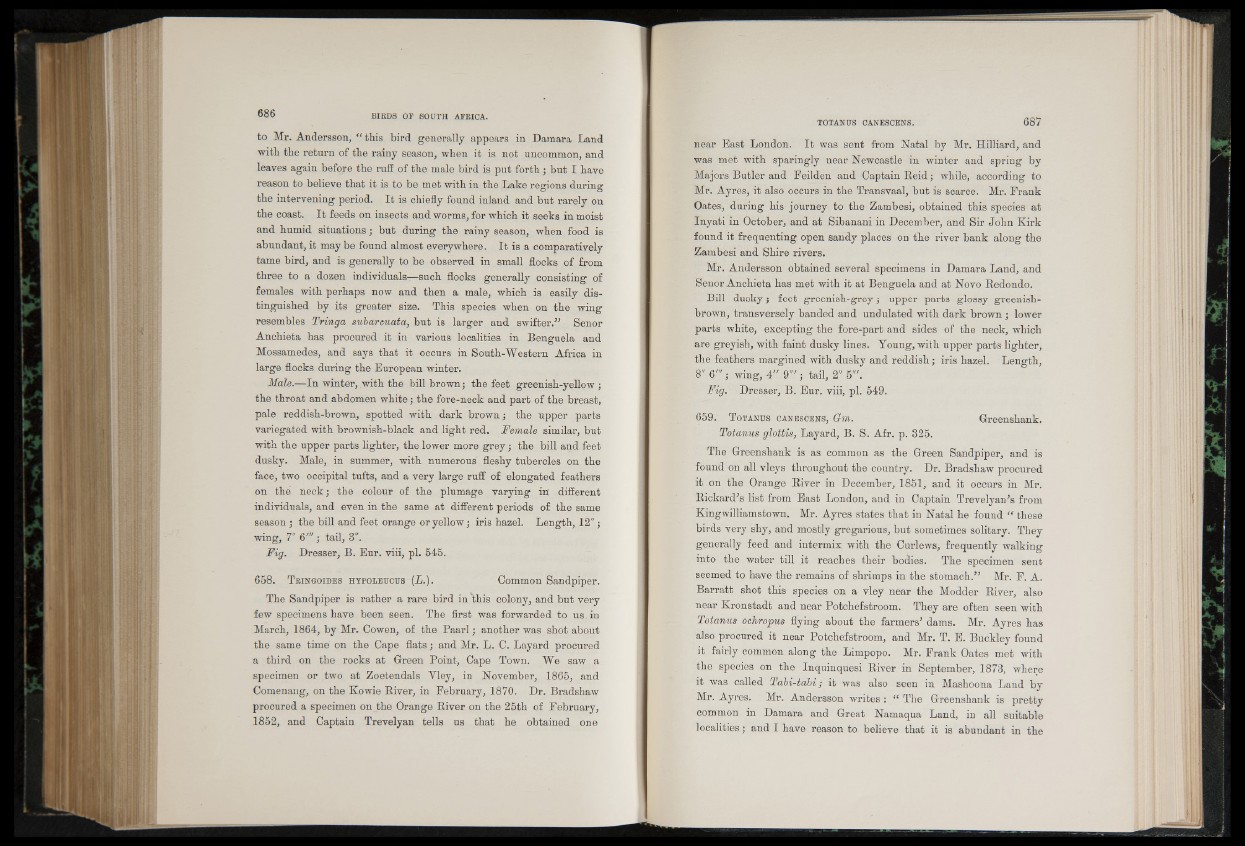
to Mr. Andersson, “ this bird generally appears in Damara Land
with the return of the rainy season, when it is not uncommon, and
leaves again before the ruff of the male bird is put forth; but I have
reason to believe that it is to be met with in the Lake regions during O o
the intervening period. It is chiefly found inland and but rarely on
the coast. It feeds on insects and worms, for which it seeks in moist
and humid situations; but during the rainy season, when food is
abundant, it maybe found almost everywhere. It is a comparatively
tame bird, and is generally to be observed in small flocks of from
three to a dozen individuals—such flocks generally consisting of
females with perhaps now and then a male, which is easily distinguished
by its greater size. This species when on the wing
resembles Tringa subarcuata, but is larger and swifter.” Senor
Anchieta has procured it in various localities in Benguela and
Mossamedes, and says that it occurs in South-Western Africa in
large flocks during the European winter.
Male.—In winter, with the bill brown; the feet greenish-yellow ;
the throat and abdomen white; the fore-neck and part of the breast,
pale reddish-brown, spotted with dark brown; the upper parts
variegated with brownish-black and light red. Female similar, but
with the upper parts lighter, the lower more grey; the bill and feet
dusky. Male, in summer, with numerous fleshy tubercles on the
face, two occipital tufts, and a very large ruff of elongated feathers
on the neck; the colour of the plumage varying in' different
individuals, and even in the same at different periods of the same
season ; the bill and feet orange or yellow; iris hazel. Length, 12";
wing, 7" 6"'; tail, 3".
Fig. Dresser, B. Eur. viii, pi. 545.
658. T r in g o id e s h y p o l e u c u s (L.). Common Sandpiper.
The Sandpiper is rather a rare bird in this colony, and but very
few specimens have been seen. The first was forwarded to us. in
March, 1864, by Mr. Cowen, of the Paarl; another was shot about
the same time on the Cape flats; and Mr. L. C. Layard procured
a third on the rocks at Green Point, Cape Town. We saw a
specimen or two at Zoetendals Vley, in November, 1865, and
Comenang, on the Kowie River, in February, 1870. Dr. Bradshaw
procured a specimen on the Orange River on the 25th of February,
1852, and Captain Trevelyan tells us that he obtained one
near East London. I t was sent from Natal by Mr. Hilliard, and
was met with sparingly near Newcastle in winter and spring by
Majors Butler and Feilden and Captain Reid; while, according to
Mr. Ayres, it also occurs in the Transvaal, but is scarce. Mr. Frank
Oates, during his journey to the Zambesi, obtained this species at
Inyati in October, and at Sibanani in December, and Sir John Kirk
found it frequenting open sandy places on the river bank along the
Zambesi and Shire rivers.
Mr. Andersson obtained several specimens in Damara Land, and
Senor Anchieta has met with it at Benguela and at Novo Redondo.
Bill dusky; feet greenish-grey; upper parts glossy greenish-
brown, transversely banded and undulated with dark brown ; lower
parts white, excepting the fore-part and sides of the neck, which
are greyish, with faint dusky lines. Young, with upper parts lighter,
the feathers margined with dusky and reddish; iris hazel. Length,
8" 6"'; wing, 4" 9’" ; tail, 2" 5'".
Fig. Dresser, B. Eur. viii, pi. 549.
659. T o t a n u s c a n e s c e n s , Gm. Greenshank.
Totanus glottis, Layard, B. S. Afr. p. 325.
The Greenshank is as common as the Green Sandpiper, and is
found on all vleys throughout the country. Dr. Bradshaw procured
it on the Orange River in December, 1851, and it occurs in Mr.
Rickard'’s list from East London, and in Captain Trevelyan's from
Kingwilliamstown. Mr. Ayres states that in Natal he found “ these
birds very shy, and mostly gregarious, but sometimes solitary. They
generally feed and intermix with the Curlews, frequently walking
into the water till it reaches their bodies. The specimen sent
seemed to have the remains of shrimps in the stomach.” Mr. F. A.
Barratt shot this species on a vley near the Modder River, also
near Kronstadt and near Potchefstroom. They are often seen with
Totanus ochropus flying about the farmers' dams. Mr. Ayres has
also procured it near Potchefstroom, and Mr. T. E. Buckley found
it fairly common along the Limpopo. Mr. Frank Oates met with
the species on the Inquinquesi River in September, 1873, where
it was called Tabi-tabi; it was also seen in Mashoona Land by
Mr. Ayres. Mr. Andersson writes : “ The Greenshank is pretty
common in Damara and Great Namaqua Land, in all suitable
localities; and I have reason to believe that it is abundant in the